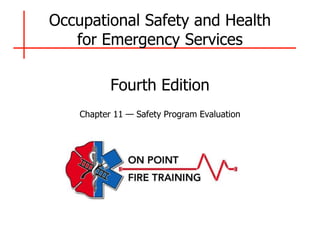Report
Share

Recommended
Recommended
Labor Markets Core Course 2013: Monitoring and evaluation 

Labor Markets Core Course 2013: Monitoring and evaluation Health, Education, Social Protection and Labor World Bank
More Related Content
Similar to 6741 Ch 11 PowerPoint.pptx
Labor Markets Core Course 2013: Monitoring and evaluation 

Labor Markets Core Course 2013: Monitoring and evaluation Health, Education, Social Protection and Labor World Bank
Similar to 6741 Ch 11 PowerPoint.pptx (20)
Methodologies for impact assessment of post harvest technologies

Methodologies for impact assessment of post harvest technologies
Labor Markets Core Course 2013: Monitoring and evaluation 

Labor Markets Core Course 2013: Monitoring and evaluation
Title of PaperYour nameHCA375– Continuous Quality Monito.docx

Title of PaperYour nameHCA375– Continuous Quality Monito.docx
Project Monitoring and Evaluation (M and E Plan) Notes

Project Monitoring and Evaluation (M and E Plan) Notes
More from NickPalmisano2
More from NickPalmisano2 (20)
Recently uploaded
God is a creative God Gen 1:1. All that He created was “good”, could also be translated “beautiful”. God created man in His own image Gen 1:27. Maths helps us discover the beauty that God has created in His world and, in turn, create beautiful designs to serve and enrich the lives of others.
Explore beautiful and ugly buildings. Mathematics helps us create beautiful d...

Explore beautiful and ugly buildings. Mathematics helps us create beautiful d...christianmathematics
Recently uploaded (20)
Measures of Dispersion and Variability: Range, QD, AD and SD

Measures of Dispersion and Variability: Range, QD, AD and SD
Unit-V; Pricing (Pharma Marketing Management).pptx

Unit-V; Pricing (Pharma Marketing Management).pptx
Explore beautiful and ugly buildings. Mathematics helps us create beautiful d...

Explore beautiful and ugly buildings. Mathematics helps us create beautiful d...
Micro-Scholarship, What it is, How can it help me.pdf

Micro-Scholarship, What it is, How can it help me.pdf
Asian American Pacific Islander Month DDSD 2024.pptx

Asian American Pacific Islander Month DDSD 2024.pptx
Z Score,T Score, Percential Rank and Box Plot Graph

Z Score,T Score, Percential Rank and Box Plot Graph
Ecological Succession. ( ECOSYSTEM, B. Pharmacy, 1st Year, Sem-II, Environmen...

Ecological Succession. ( ECOSYSTEM, B. Pharmacy, 1st Year, Sem-II, Environmen...
This PowerPoint helps students to consider the concept of infinity.

This PowerPoint helps students to consider the concept of infinity.
Python Notes for mca i year students osmania university.docx

Python Notes for mca i year students osmania university.docx
6741 Ch 11 PowerPoint.pptx
- 1. Occupational Safety and Health for Emergency Services Fourth Edition Chapter 11 — Safety Program Evaluation
- 2. Objectives At the conclusion of this chapter you will be able to: ‣ Describe the purpose of evaluating the safety and health program. ‣ Compare the two types of evaluations—process and outcome. ‣ Explain who is responsible for evaluating the safety and health program. ‣ Describe the recommended frequency of evaluation and the factors that affect the frequency.
- 3. Introduction ‣ Chapter 4 of NFPA 1500 ‣ Requires risk management plan to be monitored annually ‣ Evaluated every 3 years by an independent source ‣ New safety and health program ‣ Evaluate its effectiveness ‣ Measuring of results is necessary ‣ Compare where the organization is now to where it was before
- 4. The Evaluation Process ‣ Three reasons to evaluate ‣ See if the program is effective ‣ Determine the response from the members’ perspectives ‣ Facilitate program changes ‣ Compare outcomes ‣ Analyze statistics ‣ Changes should be considered
- 5. Process Evaluation (1 of 2) ‣ Analysis of the procedures of the program ‣ Questions that must be answered: ‣ Who was affected by the program? ‣ To what extent were they affected? ‣ Are improvements occurring as planned? ‣ Which parts of the program appear to be most effective? ‣ Which parts of the program appear to be least effective?
- 6. Process Evaluation (2 of 2)
- 7. Outcome Evaluation (1 of 2) ‣ Compares the result of the program to the goal ‣ After the program has been in effect for a while ‣ Several areas should be analyzed ‣ Current compared to prior injury rates ‣ Changes in knowledge, behavior, and performance ‣ Changes in the physical environment ‣ Responses to policy changes
- 8. Outcome Evaluation (2 of 2)
- 9. Responsibility for Evaluation (1 of 2) ‣ Fire chief, EMS director, or safety and health manager may oversee evaluation ‣ Evaluation accomplished through ‣ Safety committee ‣ Incident safety officers ‣ Senior staff members ‣ First-line supervisors ‣ Responders
- 10. Responsibility for Evaluation (2 of 2) ‣ NFPA 1500 recommendations ‣ Externally evaluated ‣ Every three years ‣ External evaluation ‣ Highly recommended ‣ Demonstrates a positive effort ‣ Find areas for improvement
- 11. Evaluation Frequency (1 of 2) ‣ Program evaluation ‣ Required component ‣ Occurs before the program even starts ‣ Process evaluation can be an almost continuous process ‣ Outcome evaluation ‣ The end of a specific period of time ‣ Usually one year ‣ Measured time frame
- 12. Evaluation Frequency (2 of 2) ‣ Frequency should be considered dynamic ‣ Evaluate if one of the following occurs ‣ A serious injury, near miss, or death occurs: ‣ Findings during a postincident analysis require evaluation ‣ New technology is introduced ‣ Changes are made to applicable regulations or standards